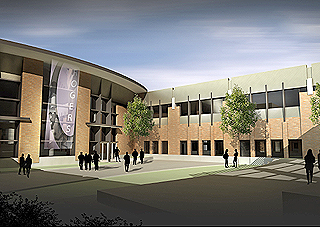|
Subscribe / Renew |
|
|
Contact Us |
|
| ► Subscribe to our Free Weekly Newsletter | |
| home | Welcome, sign in or click here to subscribe. | login |
Construction
| |
 |
September 20, 2007
Spokane takes a chance on GC/CM
Heery International

Wasserman
|
Timing is everything, especially when it comes to building design and construction. It’s critical, for example, in putting a team in place than can successfully manage challenges and opportunities.
Until recently, Spokane Public Schools, like most Washington state public schools, was limited in how it could deliver new school facilities. According to state regulations, school officials were obligated to use a traditional design-bid-build approach.
“One of the greatest challenges in using this delivery method is that decisions regarding vital issues such as phasing, project length and how to separate construction zones from occupied zones generally occur before the contractor comes on board,” says Greg Brown, Spokane Public Schools director of capital projects.
The timing of these decisions, made without the benefit of contractor expertise, can sometimes hinder the delivery of a complicated facility.
Thanks to an experimental shift in regulations, Spokane was presented with a second delivery option after passing its most recent bond issue.
“The state of Washington was allowing up to 10 districts to demonstrate the general contractor/construction manager process,” Brown says. “Districts had to apply and be selected by a special committee.”
After careful consideration, Spokane put its hat in the ring. “We had two very large, very complicated renovation and addition projects,” Brown says.
A contractor’s perspective

The first project, Rogers High School, was a $67 million historic renovation in a quiet residential community. A 180,000-square-foot addition was to be designed to abut an existing 80,000 square-foot facility housing 1,600 students.
Heery International was hired as a consultant because of its GC/CM experience.
One of the greatest challenges was that there was little room to stage construction. Because students would remain on campus, effective program phasing would be critical to ensure student safety and accommodate seasonal weather conditions.
The second project was a $71 million modernization of Shadle Park High School.
“With complicated renovations, it’s invaluable to have the contractor’s perspective up front, especially when site logistics are critical to a project’s success,” notes Heery International Vice President Ralph Rohwer. “Since both Rogers and Shadle Park high schools were being renovated with students in attendance, it was important for Spokane-based Garco Construction, the contractor, to play a role in determining where students would be throughout the construction.”
Having the contractor on board ahead of time also enabled the district to determine existing conditions before going into construction.
“We spent a great deal of time up front discussing what should be investigated to understand existing conditions,” Rohwer says.
One early discovery was that an earlier addition was structurally insufficient and had to be torn out. That information was then shared with the project structural engineer, who incorporated it into the design.
“Our goal,” Rohwer adds, “was to reduce surprises which could result in unforeseen change orders.”
Securing funds
Assessing and prioritizing key goals and issues was critical in putting out the contractor request for proposals.
“Our overarching goal was to use this new process to enhance the project’s success,” Rohwer says.
Spokane officials recognized the contractor needed to have experience completing a project with people present, be adept at managing logistics in the safest manner, and have a solid understanding of public agencies and subcontractors in the Spokane area.
A solid understanding of the intricacies of the state’s fund matching programs was also integral to success.
“Many state of Washington projects are funded with matching dollars,” Brown says. “When the bond initially passed, construction costs were lower.”
With the cost of the two projects rising close to 40 percent in four years, Brown knew that state matching funds were needed to complete the project. Unfortunately, the state approval process didn’t reflect the GC/CM procurement method. Clearly, the district was concerned about making mistakes that might void funding.
“Fortunately, Heery had worked with a variety of districts and kept an eye on the documentation process to ensure that the required forms were completed correctly,” Brown says.
Risks and rewards
Brown believes the new delivery method has helped the district reap a myriad of benefits. One of those benefits is the project’s enviable guaranteed maximum price.
“A number of school districts on the west side found it difficult to negotiate a guaranteed maximum price because of construction pricing spikes,” Brown says.
Thanks to strong contractor relationships with the owner, architect and Heery, and an understanding of the volatile marketplace, both GMPs will average less than $200 per square foot. Due to outstanding subcontractor bids, Rogers will be completed for $2 million less than the GMP.
Although Shadle’s figures aren’t yet complete, it is estimated the project, through Garco’s buyout process, will be delivered for $1 million less than the GMP.
How was the school able to negotiate such favorable prices?
“We put a great deal of effort into helping Garco understand GC/CM procedures and worked as a team to get the best numbers on bid day,” Rohwer notes. “We collectively developed a strategy during the design process to help the district achieve optimum subcontractor bids.”
In this process, the contractor can also reap significant benefits from a job well done.
“In the traditional design-bid-build approach, the liability for errors belongs to the owner,” Rohwer says. With GC/CM, the owner and contractor share the risks and rewards.
Rohwer continued: “We helped the district understand how incentives can be implemented effectively and how they contribute to project success. With the GC/CM approach, Garco will be financially rewarded if they can prevent change orders through the creation of high caliber documents.”
Brown is happy to note the money being returned to the school will be used to fund smaller district projects that had been cut from the initial program scope after the initial cost escalations on the larger projects forced the district to make difficult decisions.
Brown is also happy to note the state Legislature has passed a law that allows schools to procure construction through the GC/CM method permanently. Now that the district has learned to navigate the GC/CM waters once, Spokane Public Schools is confident the method is one it will continue using.
Sue Wasserman is public relations manager at Heery International, a 1,000-person architecture, engineering, project management and interior design firm.
(Editor's note: The headline of this story has been changed to correct an error.)
Other Stories:
- Cascadia college building will be green inside and out
- Owners, designers can harness the Web too
- ‘I wish I could go to a school just like this’
- Light ‘chimneys’ cool off Tacoma school
- Performing arts spaces gain sophistication
- Lynnwood a proving ground for green schools
- Seattle gets creative to expand bidding pool
- Public school projects fall out of favor with bidders
- Case for operable windows isn’t open and shut
- Tomorrow’s schools will be greener, freer


